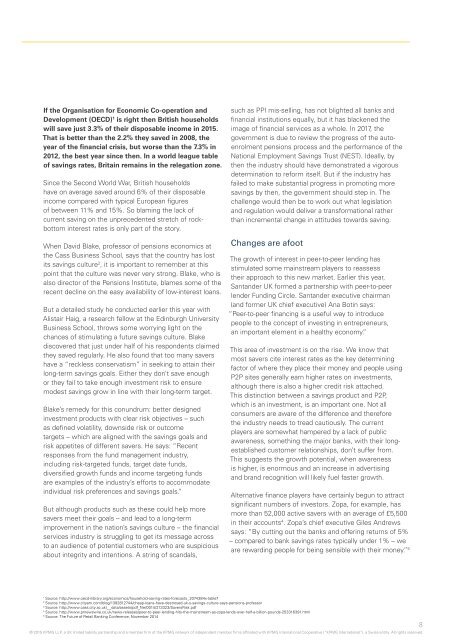17JCgsz
17JCgsz
17JCgsz
You also want an ePaper? Increase the reach of your titles
YUMPU automatically turns print PDFs into web optimized ePapers that Google loves.
If the Organisation for Economic Co-operation and<br />
Development (OECD) 1 is right then British households<br />
will save just 3.3% of their disposable income in 2015.<br />
That is better than the 2.2% they saved in 2008, the<br />
year of the financial crisis, but worse than the 7.3% in<br />
2012, the best year since then. In a world league table<br />
of savings rates, Britain remains in the relegation zone.<br />
Since the Second World War, British households<br />
have on average saved around 6% of their disposable<br />
income compared with typical European figures<br />
of between 11% and 15%. So blaming the lack of<br />
current saving on the unprecedented stretch of rockbottom<br />
interest rates is only part of the story.<br />
When David Blake, professor of pensions economics at<br />
the Cass Business School, says that the country has lost<br />
its savings culture 2 , it is important to remember at this<br />
point that the culture was never very strong. Blake, who is<br />
also director of the Pensions Institute, blames some of the<br />
recent decline on the easy availability of low-interest loans.<br />
But a detailed study he conducted earlier this year with<br />
Alistair Haig, a research fellow at the Edinburgh University<br />
Business School, throws some worrying light on the<br />
chances of stimulating a future savings culture. Blake<br />
discovered that just under half of his respondents claimed<br />
they saved regularly. He also found that too many savers<br />
have a “reckless conservatism” in seeking to attain their<br />
long-term savings goals. Either they don’t save enough<br />
or they fail to take enough investment risk to ensure<br />
modest savings grow in line with their long-term target.<br />
Blake’s remedy for this conundrum: better designed<br />
investment products with clear risk objectives – such<br />
as defined volatility, downside risk or outcome<br />
targets – which are aligned with the savings goals and<br />
risk appetites of different savers. He says: “Recent<br />
responses from the fund management industry,<br />
including risk-targeted funds, target date funds,<br />
diversified growth funds and income targeting funds<br />
are examples of the industry’s efforts to accommodate<br />
individual risk preferences and savings goals.”<br />
But although products such as these could help more<br />
savers meet their goals – and lead to a long-term<br />
improvement in the nation’s savings culture – the financial<br />
services industry is struggling to get its message across<br />
to an audience of potential customers who are suspicious<br />
about integrity and intentions. A string of scandals,<br />
such as PPI mis-selling, has not blighted all banks and<br />
financial institutions equally, but it has blackened the<br />
image of financial services as a whole. In 2017, the<br />
government is due to review the progress of the autoenrolment<br />
pensions process and the performance of the<br />
National Employment Savings Trust (NEST). Ideally, by<br />
then the industry should have demonstrated a vigorous<br />
determination to reform itself. But if the industry has<br />
failed to make substantial progress in promoting more<br />
savings by then, the government should step in. The<br />
challenge would then be to work out what legislation<br />
and regulation would deliver a transformational rather<br />
than incremental change in attitudes towards saving.<br />
Changes are afoot<br />
The growth of interest in peer-to-peer lending has<br />
stimulated some mainstream players to reassess<br />
their approach to this new market. Earlier this year,<br />
Santander UK formed a partnership with peer-to-peer<br />
lender Funding Circle. Santander executive chairman<br />
(and former UK chief executive) Ana Botin says:<br />
“Peer-to-peer financing is a useful way to introduce<br />
people to the concept of investing in entrepreneurs,<br />
an important element in a healthy economy.”<br />
This area of investment is on the rise. We know that<br />
most savers cite interest rates as the key determining<br />
factor of where they place their money and people using<br />
P2P sites generally earn higher rates on investments,<br />
although there is also a higher credit risk attached.<br />
This distinction between a savings product and P2P,<br />
which is an investment, is an important one. Not all<br />
consumers are aware of the difference and therefore<br />
the industry needs to tread cautiously. The current<br />
players are somewhat hampered by a lack of public<br />
awareness, something the major banks, with their longestablished<br />
customer relationships, don’t suffer from.<br />
This suggests the growth potential, when awareness<br />
is higher, is enormous and an increase in advertising<br />
and brand recognition will likely fuel faster growth.<br />
Alternative finance players have certainly begun to attract<br />
significant numbers of investors. Zopa, for example, has<br />
more than 52,000 active savers with an average of £5,500<br />
in their accounts 4 . Zopa’s chief executive Giles Andrews<br />
says: “By cutting out the banks and offering returns of 5%<br />
– compared to bank savings rates typically under 1% – we<br />
are rewarding people for being sensible with their money.” 5<br />
1<br />
Source: http://www.oecd-ilibrary.org/economics/household-saving-rates-forecasts_2074384x-table7<br />
2<br />
Source: http://www.cityam.com/blog/1392812744/cheap-loans-have-destroyed-uk-s-savings-culture-says-pensions-professor<br />
3<br />
Source: http://www.cass.city.ac.uk/__data/assets/pdf_file/0014/213323/SaversRisk.pdf<br />
4<br />
Source: http://www.prnewswire.co.uk/news-releases/peer-to-peer-lending-hits-the-mainstream-as-zopa-lends-over-half-a-billion-pounds-253316391.html<br />
5<br />
Source: The Future of Retail Banking Conference, November 2014<br />
© 2015 KPMG LLP, a UK limited liability partnership and a member firm of the KPMG network of independent member firms affiliated with KPMG International Cooperative (“KPMG International”), a Swiss entity. All rights reserved.<br />
8


